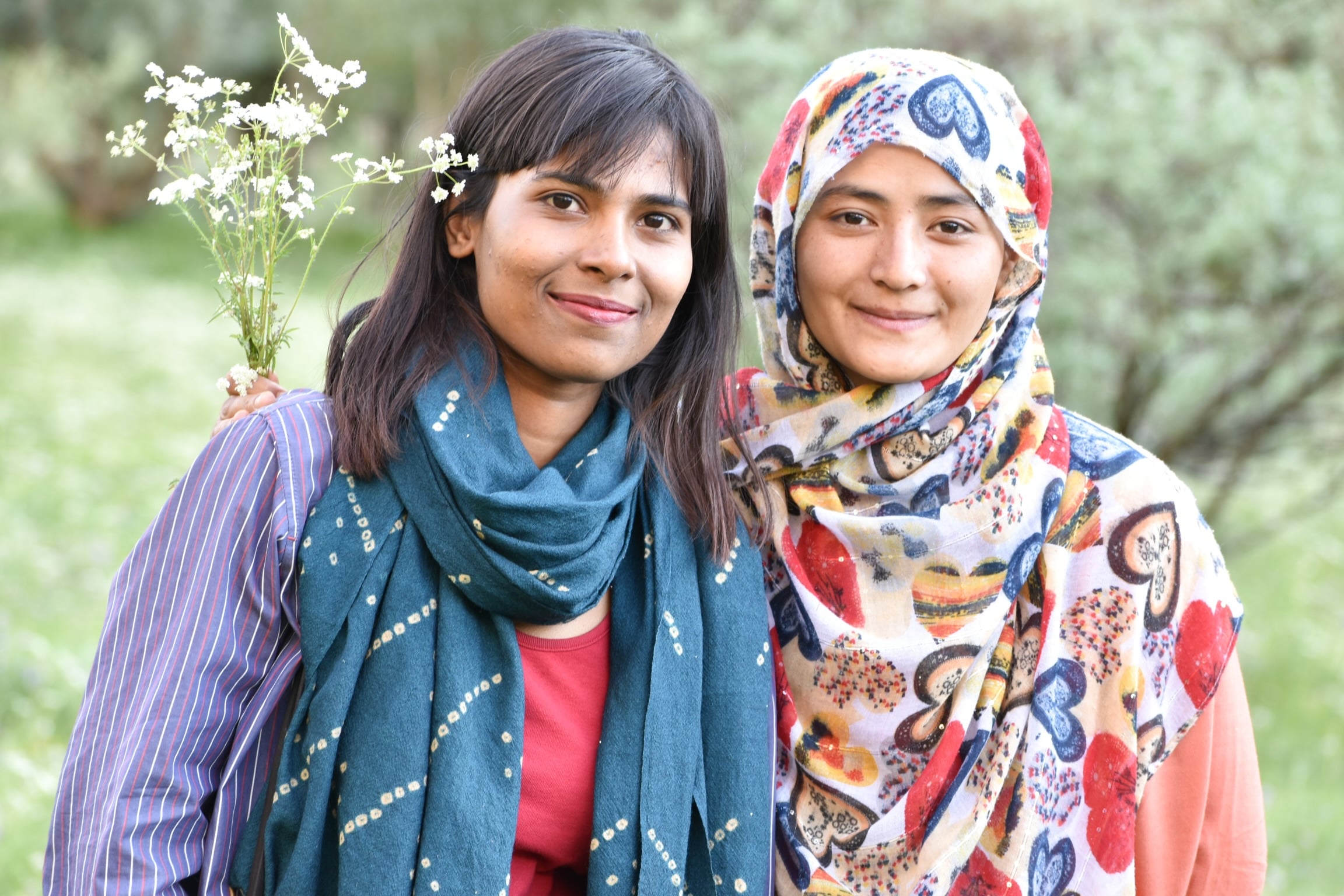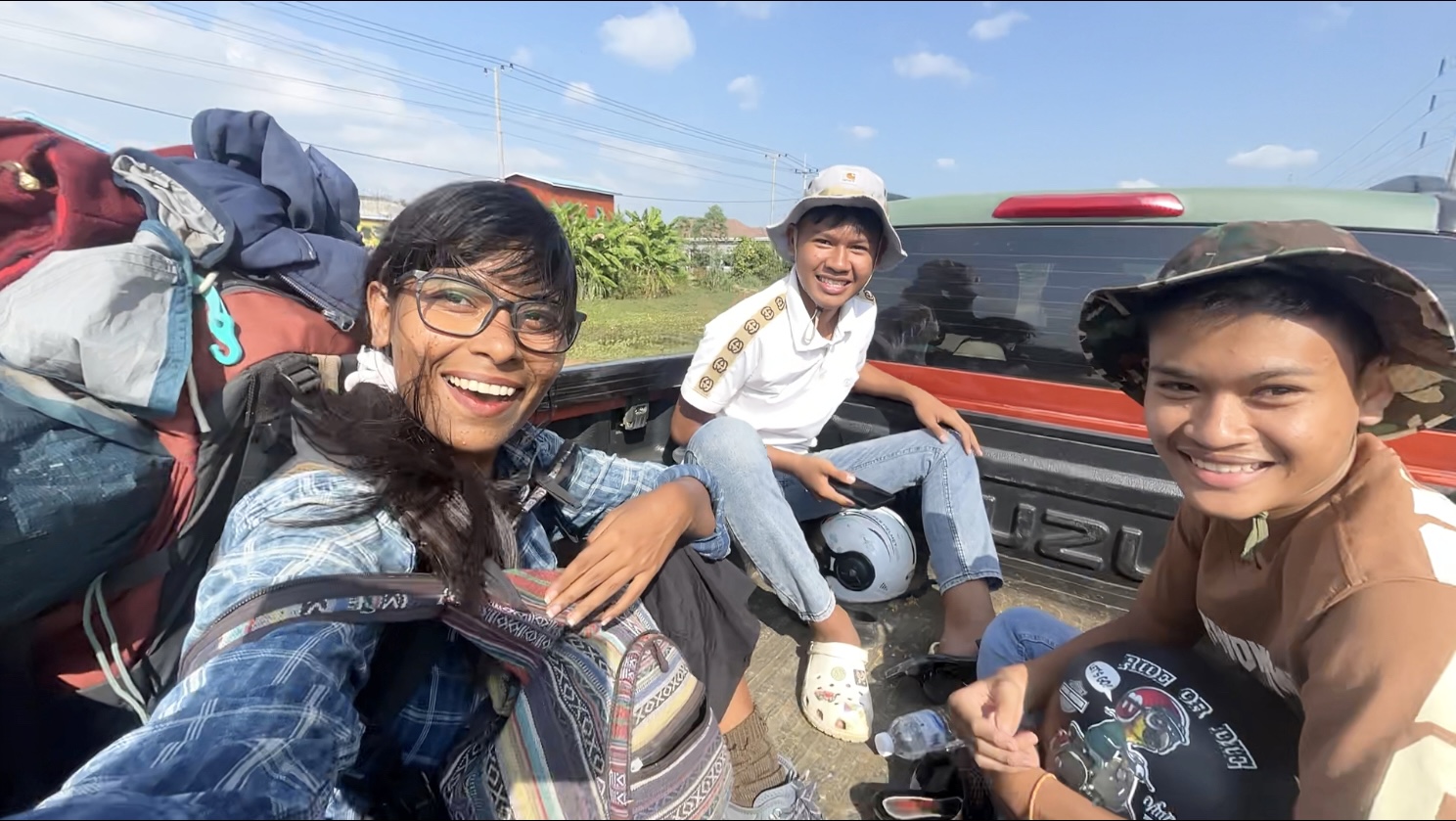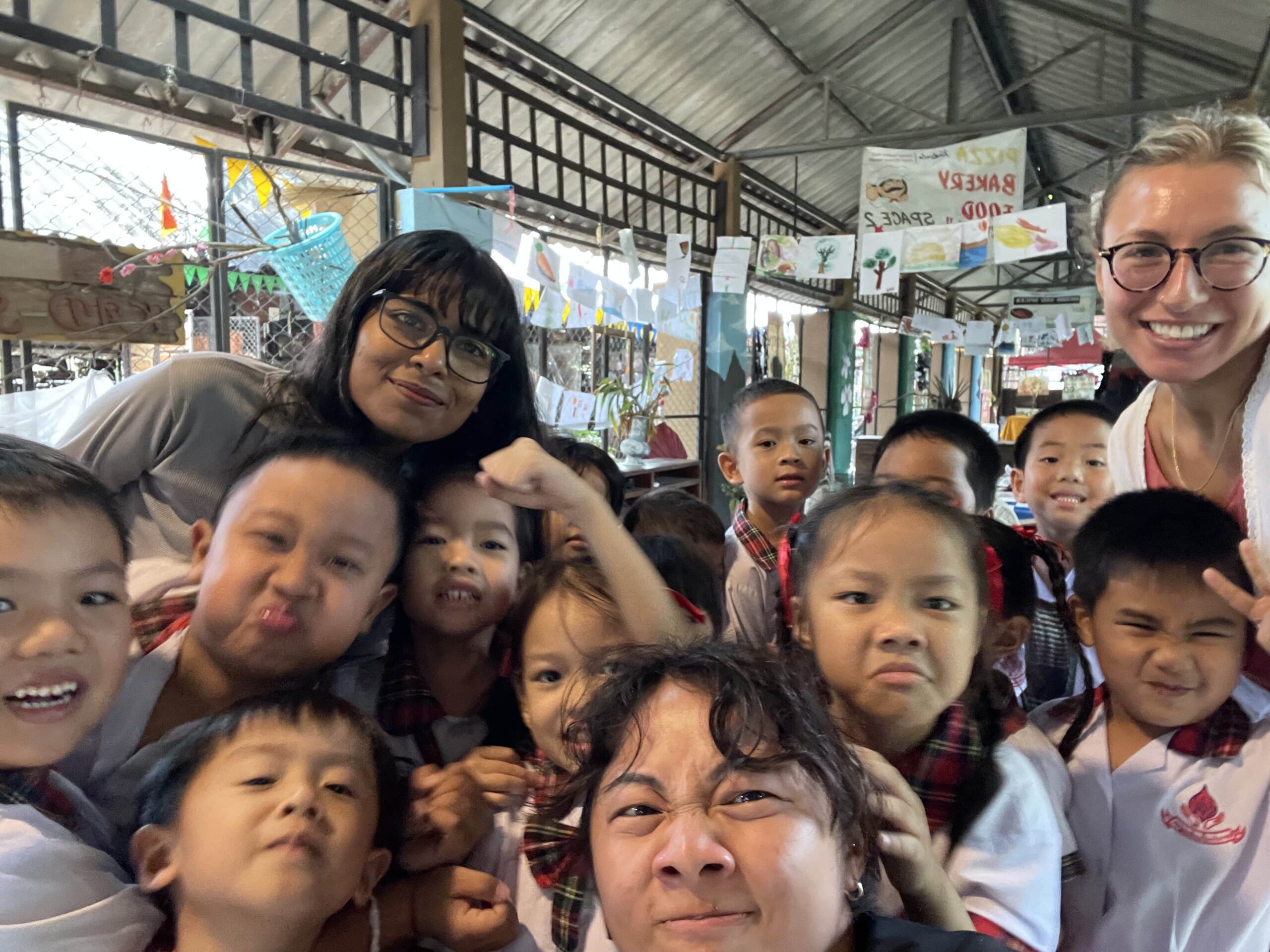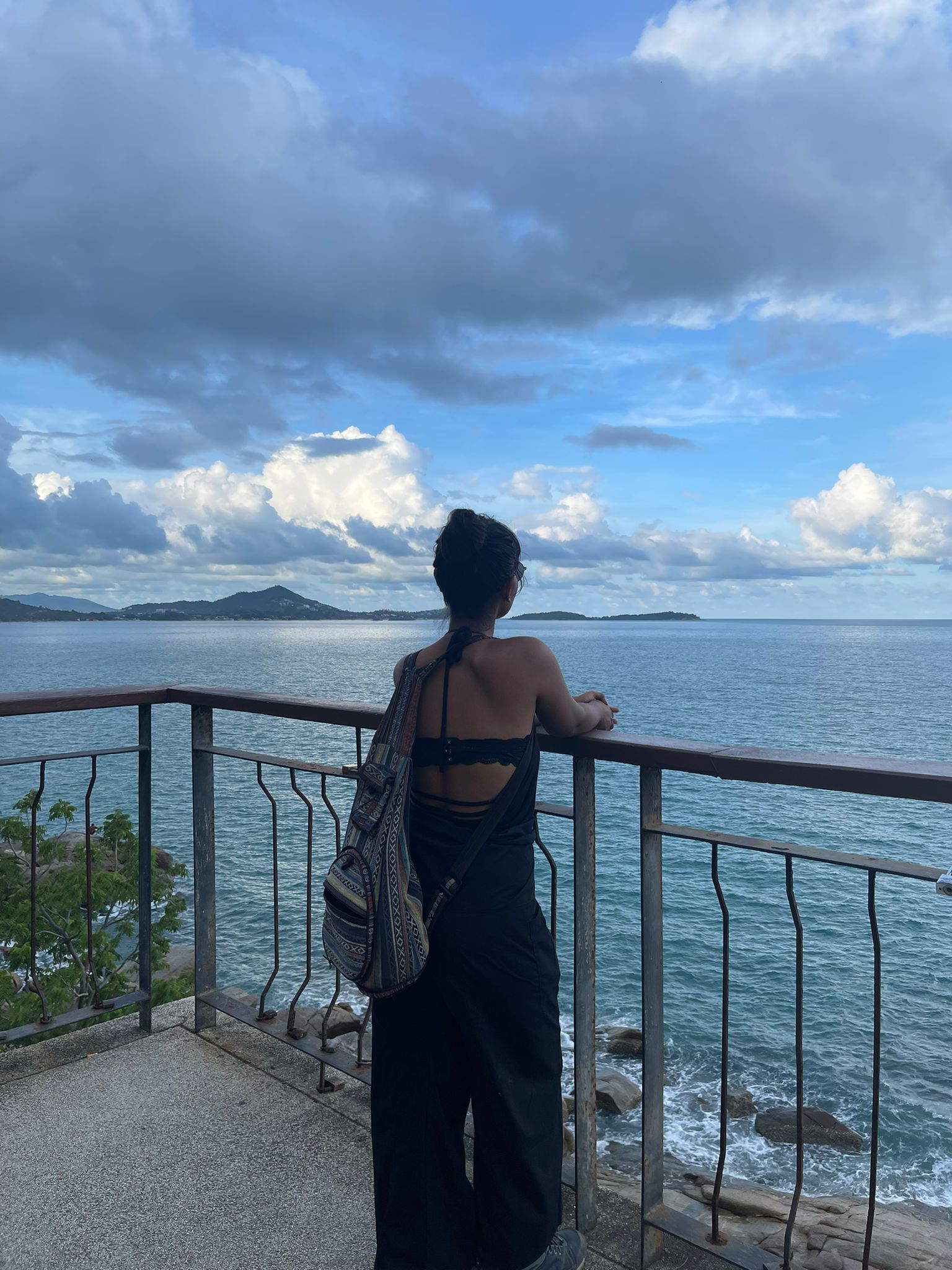‘Young Artists of Kargil Ladakh’ – a group of 30 Ladakhi women, led by Bob Sir, is painting the schools of Kargil to bring a cent of sustainability to their lives.
It was one of those ‘dreams’; the chosen few. I hardly ever truly ‘dreamed’ in a coherent sense. The Northern Lights and the ‘Shakespeare & Co’ bookstore in Paris – my childhood had its dreamy shares. But then my general ‘dream conformation’ doesn’t have the binding and blinding visions. I have more abstract sidebars, not prominent landing pages, for dreams are meant to emerge, with the prominence of disappearance, existing on a flimsy Hollywood action-plot in a fairy dimension. Good or bad – dreams exhume the same ideology – the momentary attachment.

I think I feel the need to share what I mean when I say, I always dreamed of volunteering in Kargil, at the India-POK Border. Back in Kolkata (my hometown), wrestling with the baleful existential crisis I couldn’t purge, and volunteer-teaching in shelter homes for an NGO called Bhumi, I would often nag, in months of rotation, to my best-friend-cum-sister with ‘I want to go to Kargil. I want to teach the kids there. Not in Kolkata!’ How I picked Kargil up, among all places, has everything to do with our dividing geo-relations between India and Pakistan, and the way my contemporary interpretations around the border had piled up in my mind; remote, vulnerable and dismissive. But was it? Was it remote? Was it vulnerable? Was it dismissive?

Years later, as chances and circumstances gushed into a fluid and freezy middleground, I caught myself leaning on the wooden railings from Bob Sir’s parents’ mudhouse for the 134-degree open sunset suspending over the town of Kargil, like an apocalypse flirting in shots of yellow and shoots of blue-pinned slapdash clouds. Bob Sir’s nieces and nephews curiously peeked from behind the half-ajar door to call me to the kitchen. But I was with the sunset. I was the ‘dream’.
‘Team Stringmo’ And Bob Sir Brought Me to Kargil

‘The name of our group used to be Young Artists of Kargil Ladakh’, which was founded through WAVE Foundation Ladakh, during the pandemic.’ Zainab’s recited voice has a thicker concessional note, a narrator’s artistry, not a boss’ authority. The green hijab (headscarf) devises a triangular division in folds around her kindred sharp face that draws shyness. ‘There’re 30-35 girls in this group. We all are from different villages in Kargil.’
Now they have changed their name to ‘Team Stringmo’. ‘Stringmo’ in Ladakhi means ‘sisters’. Sisterhood.
But the man who weaved this intricate web, under the threads and needles of rather a stronghold Muslim society so happened to be Bob Marley’s namesake! Sajjad Hussein aka Bob Sir. He named himself Bob, as a testament to his inspiration, Mr. Marley. All you got to do: give a little.
The coarse depth of a world pandemic persuaded Bob to retaliate against his own culture, in his own way, the way he said, ‘This is a patriarchal social set-up. We have to push our girls a little by little. I often get questions and squinted eyebrows on what ‘exactly’ I am doing with so many girls. And only girls!’

Lily’s eyes vanquish only when her smile digs out the curves of her face and when the sun rays poke her cataracts, in Kargil’s parching summer heat. The heat of the semi-desert regions of Ladakh dissuades the skin from wandering and wondering about how the icy-cold winter exists only to complement its better self. But life goes on, on an ecological stick, on both poles. Many Ladakhis like Lily and Zainab bury the winter and shadow the summer, for thousand centuries to be enlivened, if the changing climate hardships (or should I say ‘human atrocities’) do not snub off the sorcery of Ladakh’s fundamental cycle!
But then my general ‘dream conformation’ doesn’t have the binding and blinding visions. I have more abstract sidebars, not prominent landing pages, for dreams are meant to emerge, with the prominence of disappearance, existing on a flimsy Hollywood action-plot in a fairy dimension. Good or bad – dreams exhume the same ideology – the momentary attachment.
‘Now we do mural painting in different schools in Kargil, so that the students can visually learn, especially those in primary schools, because they spend most of their time in classrooms.’ Rooqsana said.
Another Kaneez (We call her ‘Kaneez the Third’) tells me, ‘We teach the students different forms of painting, like Notan Art, Pebble Painting, and Mandala Art.’

This group of women has painted over 50 government schools all over Ladakh, playing on the double-edged card of sustainability. While these painting projects bring an extra income source, the kids’ white-blocked wallpapers peel out ice cubes of dreams in imagination and animation. Their world, an addle-headed square-box, in a flash and sweep of brushes, exorcises a portable discovery. Shapes take shape, circles swipe the buns of Mickey the Mouse, the planets swirl around the orbits, the walls manifest the firmament… And these women bond over a shared love for painting.
Kaneez Fatima from Kargil, now 22, leads the group as the ‘President’, the sweetest soul. Bob Sir’s consistency around bringing in outsiders and travellers from diverse creative backgrounds, may it be web designing or meteorological observation (weather patterns and forecasting techniques), or a unique form of art, attracts the foyer of external possibilities/exposure to these Ladakhi women, who in sequence, conduct further workshops for the school children. Not just that, under WAVE Foundation, their bold ingenuity around streamlining the importance of sanitary pads in remote Kargil villages needed an extra thick layer of guts and unconventionality. They are in the mill of constantly learning and ever-constantly contributing.
Also read – Zanskar in the Lights & Shadows of Life
Kargil War, And Decades of Peace at the Border

That sunshine ‘dream’ that spilled itself out in somewhat a synonymous cocktail of Kolkata’s garbage and my contextually unsatisfactory life, parades back, now magnified in a spike into the wooden bridge that creaks on selected beams, the mosque with a dark green cap, in what I call the ‘Kargil roads’ with a pulsating religious vibration in its veins, the texture of the stories of the last India-Pakistan conflict in 1999…
‘My teacher got shot right in front of me. Nobody knew where it came from. Not yet. Until we did. In a few minutes. I was 15. We were in the classroom.’ I can’t name the person.
‘The first blow came from Pakistan. If I am not wrong, it was a Shepherd who first spotted the Pakistani army, shrewdly approaching. He ran to alert the Indian Army at the nearest checkpoint in Kargil.’ He is from the management team of another school, where on a certain weekend, we went to paint. I was just accompanying.
‘We had to evacuate immediately. We all moved to Leh until things got normalized.’

Then there are stories of empty phone calls. The telephone wires between two flips of the border that are not connecting; expectations and threads, shredded. An Indian woman wanting to call her relative in Pakistan; proposing a once-in-a-lifetime meet-up, an open border even for a day.
‘I wish I could go to Pakistan’, and that would be me. I was cautioned against saying such things out loud. ‘People still feel strongly about this. They have suffered, you know.’ Skardu, the surreal landscape that expands beyond the Kargil border, is now Pakistan’s. Not ‘ours’. ‘Theirs’. These words trawl for no questions. It is what it is. In the practicality of it all. Ours. Theirs.
Hundarmaan is the Last Indian Village before Pakistan-Occupied Kashmir
Just about the stint of a blurry figure of a Pakistani soldier. He gets captured into a round space through the telescope with an installed lens at Hundarmaan LoC (Line of Control) Kargil Viewpoint, the last abandoned Indian village before POK (Pakistan-Occupied Kashmir), with a heavy army curtain that doesn’t appear to the glass-less eyes. Heavy army postings are not in clean sight; somewhere in camouflage at Ladakh’s distinguishing light-and-shadow yellow and brown semi-desert.

Think of a -30 degree winter, and the army patrolling on the ice. ‘See the snow up there? And that’s the snowman!’ Bob Sir makes me peer through the binocular stationed for tourists. The trail is right in front; the trail to Pakistan that could have taken me to Skardu. Or Skardu to Kargil. The ancient silk route.
Ever since the British deployment and the mass-genocide partition of India-Pakistan in 1947, Hundarmaan stayed under Pakistan’s control. But again in 1971, on the awake of the Bangladesh Liberation War, the Indian Army captured Hundarmaan and ever since, it has remained on the Indian side.
“When the India-Pakistan war erupted in 1971, people took to the caves for shelter and witnessed the destruction from close quarters. Few families fled to the next village in Pakistan, while most families stayed back and helped the Indian Army with food and other supplies. The families that took refuge in Pakistan communicated with their relatives in Hundarmaan Kargil through letters until a few years ago.” The plaque reads. Hundarmaan now is an abandoned village, with a museum preserving the Purgi culture and its low rock houses.
Also read – Lamas Dancing in Masks at Phyang Tsedup Festival Ladakh
Kargil, My Girls, the Ladakhi Ways And Teaching in A School

I can see Kargil levitating behind my half-beaten closed doors. I see the road to the school committee head’s cousin’s guest house for my one-month stay, the fruit seller who owed 20 rupees from me, the restaurant that cooked cauliflower every day to my yet-to-realize realisation of bloating, the alleyway with wooden outward railinged houses, Nasra’s haven, and then the school… where the kids squatted on the prayer hall reiterating verses of the Quran. What’s Ladakh without the sound of pouring Gur-Gur Chai (Salty Butter Tea) on fancy handy cups every hour! It suits Kargil. Indulgence. Relishing. Adaptation. Hardship. The thick local bread that is enough filling for one belly. Two for Ladakhi bellies!
This group of women has painted over 50 government schools all over Ladakh, playing on the double-edged card of sustainability.
Nobody says ‘no’ to butter tea; not even for the fifty-seventh time. Ladakhis don’t believe their ears, or they choose to turn deaf, when you say ‘no’ after putting down ‘only’ the second cup. A cup has to stay full – that’s the unwritten law of fulfilment in Ladakh. Ladakh’s philosophy of ‘refilling the cup with tea’.

It was with a bit of indulgence I made the decision to conduct a full-blown 10-day workshop on ‘Documentation in Words’ for my Kargil girls, especially slipping into Bob Sir’s persuasion, not knowing if I was in fact the right person to carry such a weight. I mean what do I know? I was 25! A writing workshop! Normally I would have backed out, but I indulged. I indulged to understand how that might ripe out. To answer back to my creative curiosity.
As time scooped in, contemplating the built of the structure, on the fourth or fifth day, I suddenly found myself discovering more concrete foundations around my own idea and way of writing. Things I never realized while holding the pen on paper, until then, in dissection of my own little world, I could give more words to my abstractions.

We would hike from our workshop place to my room, in shortcuts; almost half an hour that Nasra and I shared. Nasra was in the confusing process of getting into college after graduating from high school. Her sketches are live images of Kargil’s accurate business; every house, the red bridge-top, moving cars by the Indus River… A town dispersed in uncentered settlements, like the long legs of scorpions, on an aesthetic screen. It’s a town, but then somewhat its mobility entices a strong cultural locus. It has its root elements; water, smell, wood, mosque, apricots, spices… Then some days Kaneez joins us as well on our Kargil walk. We talk, from time to time, about this and that. ‘My religion commands women not to travel. I believe in my religion, but then, I also want to travel! What do I do?’ Kaneez asked me abruptly. Her face wards off any speculation. She is thinking, really thinking.
The metal crossover downsizes under the pressure of our feet, as we stealthily cross a neighborhood canal. ‘Do you see the water flowing? You notice the current moving from right to left? Do you want to flow in the opposite direction, against the current? You will need more force, more resilience and undercuts. But just know that you can always, always choose to either move against the current, or to follow the same convenient way.’
Also read – Food in Ladakh – Go Local with These Traditional Dishes
I Never Said Goodbye to Kargil, Or to Any Place for That Matter

A coffee mug with my printed picture with Nasra. I am in my baggy purple shirt tucked in long black pants, with a side ponytail, looking like an adolescent, showing Nasra something in her notebook. And Nasra, with a little girl’s air, relishes a capture on screen. And on the mug’s other side, a group picture of us. Huddled in a huddle. Kargil. It’s all printed. In my memory palate. And in the memory of that mug. ‘I, Kaneez Fatima, on behalf of the…’ Kaneez tries a speech in broken English, ‘…show gratitude from the bottom of our heart…’ Someone shoves a wrapped box up my palms.
‘I smell a cake!’ Why did I smell a cake? ‘Is it a cake?’
‘No!’ The girls giggled.
Standing at the opposite corner of Nasra’s house, I opened the box and took out the mug. Through the semi-transparent wrapping polythene, my picture didn’t register to me at first. ‘Is that Bob Sir?’ I spruce up the plastic. ‘Oh no! It’s me!’ I melted like honey, in the sweetness.

I was volunteering at the school and conducting the workshop for ‘Team Stringmo’ simultaneously, more in a row – so my hands were full. But Bob Sir would arrive with his jeep, kind of over-enthusiastically oftentimes, to take me to Hundarmaan, or throw the girls in for a mountain hike. Even the Police Department of Kargil Ladakh offered us an all-expenses-paid day-trip to Suru Valley, the intermediate getaway to Zanskar. Their driver assisted us throughout our little picnic on the grass, in a much greener part of Ladakh that is Suru Valley, with no internet and more of running around for running water. That night we slept in a government bungalow at Suru Valley’s main town Sankoo. At no expenses.

At the next dawn, colliding with the girls’ wake-up call to a hot and new day, I had to take the bus back to Kargil. I had a class to teach, which later got dismissed. What was I hurrying for? But I didn’t know that back then. On the bus, I happened to sit beside the principal of a school from Suru Valley. Most of the schools in Kargil are just mere ‘schools’ with no qualified teachers or a sound understanding of learning. They exist, because they are supposed to exist; because the students exist, the teachers exist. Instruments.
A town dispersed in uncentered settlements, like the long legs of scorpions, on an aesthetic screen. It’s a town, but then somewhat its mobility entices a strong cultural locus.
‘Would you come volunteer at our school? We will provide everything for you. But we really need people.’ The principal saves his number on my phone. And I would keep hearing the plea multiple times, from multiple people. It is really Bob Sir’s own and singular initiative to create an inbound network of volunteering opportunities at schools in Kargil; Suru Valley or Drass, and like a hospitable caretaker or caregiver, he connects potential volunteers with Kargil. Drass in winter, is one of the coldest places on Earth; and his secret mission is to place me there, someday, when I would have the guts to endure a -40 or 45 Ladakhi winter in Drass!

I finally met the school committee on my last day. A small farewell party with coffee and fried snacks; little interactions, little badges, little gestures. The little things that leave an indelible print on this little and wonderful life. Holding a big packet of dry apricots and a Handloom shawl, I stood by them for the last picture.
What can I say? Volunteering in Kargil will always be a realization of many things I can and cannot document in written words here. Some things made me think, reconsider and also rejoice. And with all that, those girls scored my love.
Has Kargil been part of your travels in any way?
Support my solo adventures across the globe by joining the Patreon community!
Live the Adventure
Get weekly articles delivered to your doorstep and stay up-to-date with my new travel stories.





Leave a Reply